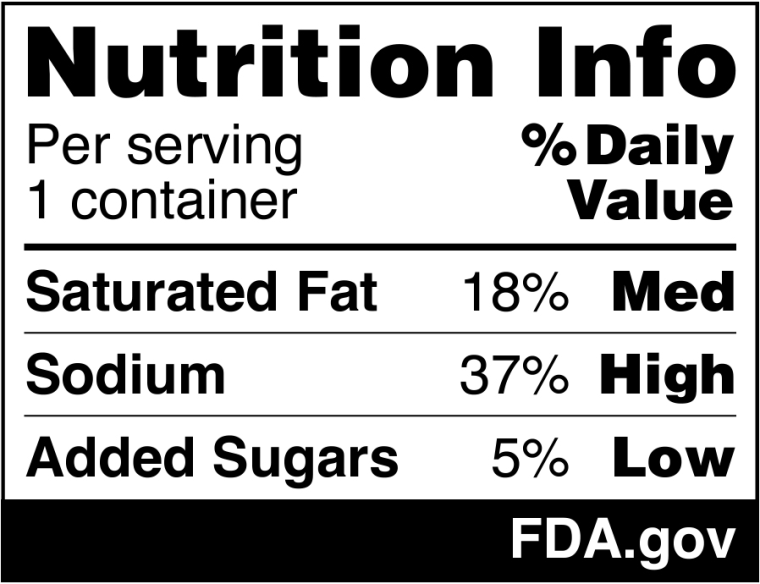The Food and Drug Administration on Tuesday proposed a new rule for nutrition labels on packaged foods and beverages, designed to help people make healthier choices at a glance.
Under the proposed rule, which shoppers could see as early as 2028, food manufacturers would also be required to report saturated fat, sodium and added sugar content on the front of packaging, in addition to standard back-of-pack nutrition labels.
Packaged foods in the United States often come with a variety of health and nutritional labels, which can make it confusing for consumers to know what is good or bad for them, said Lindsey Smith Taillie, a nutritional epidemiologist at the University of Gillings School North Carolina Global Public Health.
Fruit drinks, for example, might advertise high vitamin C content on the front of the bottle, making them seem like a healthy choice, but at the same time they are loaded with added sugar, Smith Taillie said.
The idea is that by providing specific nutritional information directly, consumers are more likely to make health-conscious decisions.
“We believe food should be a means of well-being, not a contributor to chronic disease,” Rebecca Buckner, FDA deputy director for human nutrition policy, said in a call with reporters.

The FDA’s proposed front-of-package label would include the amount of saturated fat, sodium and added sugar and indicate whether those amounts are considered “low,” “medium” or “high.”
FDA officials said the label it landed on was supported by scientific evidence, including a series of research, consumer focus groups and an agency study of nearly 10,000 adults that examined how people respond to various possible designs responded.
Saturated fat, sodium and added sugar were chosen as the three nutrients because research shows they are leading contributors to chronic diseases, including cancer, heart disease and diabetes, Buckner said.
“I think people want to know this information so they can make good decisions,” Dr. Yian Gu, a nutritional epidemiologist at Columbia University Medical Center in New York City.
The additional information won’t be of much use if people aren’t aware of how certain nutrients like saturated fat can affect their health, Gu said, adding that more work needs to be done to educate people about their diet.
The FDA proposed the labels because the United States has high rates of diet-related chronic diseases such as type 2 diabetes and heart disease. According to the Centers for Disease Control and Prevention, heart disease is the leading cause of death in the United States, accounting for one in five deaths. About 1 in 10 people have diabetes, mostly type 2 diabetes. And about two in five adults are obese, according to the CDC.
“These diseases don’t come out of nowhere,” Gu said. “If people aren’t aware of the science behind all this nutrition, they won’t pay attention to it.”
According to the FDA, the front-of-package labels would not take effect immediately. The proposal includes a 120-day comment period, after which the agency may make additional changes to the proposal or finalize the new rule.
Large food manufacturers would have three years after the rule takes effect to make the changes to most of their products, the agency said. Smaller manufacturers would have an additional year to implement the changes.
Although this is not the FDA’s intent, Buckner said the new food labels could prompt food manufacturers to reformulate their products so they could move into the “low” or “medium” categories.
The Consumer Brands Association, an industry group, has opposed mandatory labeling, saying the FDA is considering “systems with arbitrary standards and symbols that could cause confusion among consumers.”
Sarah Gallo, senior vice president of product policy at the Consumer Brands Association, said in a statement that the group has instead pushed the FDA to collaborate on industry-led initiatives, including Facts Up Front, which allows food manufacturers to voluntarily summarize key nutritional information – like Calories, saturated fat, sodium and added sugars – on the front of the package. The industry has also introduced SmartLabel, which allows consumers to access detailed nutritional information through QR codes, Gallo said.
Will the labels impact consumer habits?
Placing nutrition labels on the front of packages is not a new concept – at least outside the US. Dozens of countries, including the United Kingdom, Mexico, Chile, Australia and New Zealand, have implemented similar measures.

In 2016, Chile introduced mandatory front-of-package labels to alert consumers to high levels of sugar, saturated fat and other potentially harmful ingredients.
In 2022, Brazil also introduced mandatory front-of-package labels for products.
Colleen Tewksbury, an assistant professor of nutrition science at the University of Pennsylvania, said research shows that the labels actually influence what people buy in these countries.
However, she said the findings may not translate as easily to the United States, where “individualism” prevails and consumers “don’t want to be told what to do.”
She said often the people who change their buying behavior are already looking for change.
“Research shows fairly clearly that very simplified packaging labeling gets people’s attention, but the second step to that is whether or not it changes purchasing behavior,” Tewksbury said. “We really don’t know if it will fully impact people’s purchasing habits.”
Smith Taillie of the University of North Carolina questioned whether the new label would help people make healthier choices, noting that the design is similar to what is already found on the back of food packages.
She also said the front-of-package label could cause confusion among shoppers because it includes daily value percentages and a low-to-high ranking system.
“A ‘low’ sugar content on a product that normally contains no sugar anyway could lead consumers to believe a product is healthier than it actually is,” she said.
Additionally, she added, products that come in small portion sizes — like salty potato chips — are unlikely to receive the “high” label, which also gives people the wrong impression about their health.




Thank you for your articles. They are very helpful to me. May I ask you a question?
sure.